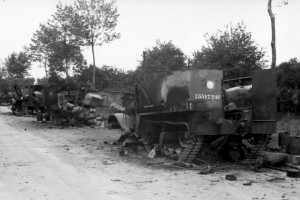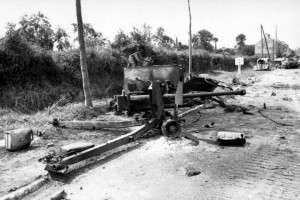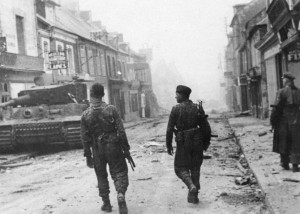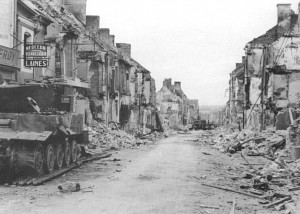The issue of the impact of Michael Wittmann’s assault at Villers-Bocage and the outcome – including the number of vehicles destroyed during the assault – has long been the subject of heated debate among historians and commentators.
Conclusions: The Impact and the outcome
While those associated with the German propaganda machine would naturally bloat the figures to enhance the significance of the feat, even after a more sober and critical analysis it remains one of the most significant feats of arms by the German forces during the war.
The events of 13th June 1944 certainly made a dent in the Allied advance, but by the end of the following day the British had recovered and regrouped. Brigadier Hinde’s pragmatic decision to consolidate his forces and reestablish their position west of the Villers proved decisive, and the Germans would eventually take the town in the first week of August – following a strategic withdrawal from the British forces.
By this time, the town had been pounded to rubble.
How many? An analysis of the numbers
The official German reports had credited Wittmann with anything between twenty and twenty-seven tanks – as well as a number of half-tracks, armoured cars and auxiliary vehicles – and this was quickly followed by the claim that the Tiger commander had single-handedly stalled the British advance towards Caen.
The truth was somewhat less dramatic: the British aim of taking Caen had ultimately been prevented by Panzer-Lehr and other Leibstandarte forces, but the events at Villers-Bocage had provided an obvious catalyst in that it had knocked the stuffing out of the British advance.
It is not hard to find a more balanced analysis. Michael Wittmann may not have single-handedly stopped the British advance, but his actions had been a key factor in the German forces stemming the tide – temporarily, at least.
Much of the subsequent confusion about the numbers of claimed tank kills may well have stemmed from a radio broadcast given by Wittmann shortly after the event, where he had claimed the destruction of twenty-one armoured vehicles (Kampfwagen) – as opposed to twenty-one tanks (Panzers).
From the various reports I have read on the events of the morning of 13th June 1944, I have been able to calculate that Michael Wittmann destroyed twelve enemy tanks in and around Villers-Bocage and the N 175 towards Hill 213: six Cromwells, one Sherman Firefly, three Stuarts, and the two OP vehicles, one a Cromwell and the other an M4A4 Sherman. Considering that he had also destroyed a not insignificant number of other armoured vehicles including half-tracks and Bren gun carriers, his total claimed figure of twenty one enemy vehicles was not wholly unreasonable.
With the British in disarray the German forces had continued to mop up isolated elements around the settlement, and following Wittmann’s arrival in Chateau d’Orbois Panzer-Lehr had initiated their own attack, accompanied by the 1st Company of the 101st LSSAH led by Rolf Möbius. By this time the element of surprise had been lost, however; there was to be no repeat of that morning’s rout.
While the Allied advance staggered to a halt in Villers-Bocage, it was not the disaster that had been shaped for public consumption by the German newsreel producers and the editors of the popular armed forces magazine Signal.
While Michael Wittmann may not have won the battle single-handedly as the German propaganda bulletins at the time suggested, his bold and instinctive action on that fateful June morning was without doubt the catalyst for an action that would drive the enemy out of Villers-Bocage, leaving them reeling and on the defensive. Operation Perch had ended in failure, and it was one of the very few occasions where the Germans would have any sort of ascendancy during the final two years of the war.
The Manipulation of the Numbers, and the Michael Wittmann radio interview
Wittmann’s attack on the morning of 13th June 1944 would have a major impact on the situation in Normandy, and it is not surprising that the German propaganda agencies took full advantage of the situation to boost morale among its beleaguered troops.
The popular magazine Signal painted a far more dramatic picture of the events at Villers-Bocage, with some reports crediting Wittmann with all of the British vehicles destroyed that day. These reports would no doubt puff up the “Wittmann myth”, and the figures were repeated by a number of commentators and writers after the war.
I myself was initially drawn in by some of the propaganda, in that most of the early texts I had read on the subject were from German sources. Since then I have been able to study the battle from a number of different angles, and while there is still some disagreement between the figures here and those presented by other researchers the differences really come down to matters of opinion and issues of interpretation.
There have been a number of discussions on various internet discussion forums about the number of enemy vehicles destroyed by Michael Wittmann at Villers-Bocage, particularly the number of tanks. Much of the controversy appears to be been derived from the radio interview with Wittmann after the battle, where he himself referred to twenty-one enemy Kampfwagen (armoured vehicles) being destroyed.
Conducted by war correspondent Herbert Reinecker, the interview provides us with an unique historical window on the wartime career of Michael Wittmann, in that we get to hear his voice – unmistakably Bavarian – as he provides his own description of the dramatic events at Villers-Bocage. As for Reinecker, he would become famous after the war as one of the creators of the hit television police series Derrick.
While the language is pretty clear – Wittmann was referring to the collection of enemy tanks, armoured personnel carriers and assorted half-tracks – some postwar writers have used this to support the story that Wittmann destroyed twenty-one tanks. We know now that the number of heavy vehicles that could be realistically described as “tanks” was closer to a dozen, but that the number Wittmann himself cites more than comfortably covers the number of enemy vehicles destroyed on that eventful June morning.
It is highly likely that Wittmann was provided with the numbers for the purpose of the interview; he is unlikely to have been counting the vehicles being destroyed from all angles with both cannon and machine-gun fire during the heat, smoke and confusion of battle.
The discussion will no doubt rumble on and the exact figures may never be determined, but one thing is clear. When he made the decision to turn against the British armour and take his Tiger into Villers-Bocage, Michael Wittmann had set out on a path that would write its own chapter in the history books.
The “Huet-Godefroy Tiger”
Apart from the number of British vehicles destroyed during the attack, one of the major questions that has arisen concerns the final location of Wittmann’s damaged Tiger. While some commentators have placed it inside the town outside the Huet-Godefroy store – corroborating Wittmann’s own version of the story – others such Daniel Taylor have placed it further east along the Route Nationale 175 close to the Tilly junction.
Both of the available theories can be made to make sense: Wittmann’s final position on the morning of 13th June can be placed by the Tilly junction given that (a) Wittmann claimed to have been hit by a shell from a six-pounder gun, and (b) the only weapon of this type on the entire route had been the one that had survived the firefight during the Tiger’s initial charge into Villers-Bocage.
However, this conflicts with the photographs of the disabled Tiger taken outside the Huet-Godefroy store on Rue Pasteur – which is clearly seen facing east. Given that all of the other disabled Tigers from Möbius’s 1. Kompanie can be seen facing west – consistent with the general direction in which they had been heading during the second attack on the town in the afternoon – the direction of the Tiger outside Huet-Godefroy doesn’t appear to make any sense.
Then there is the issue of the tactical marking that would have been visible on the front hull of the “Huet-Godefroy” Tiger. While the Tigers of Möbius’s 1. Kompanie were marked with an “S” in a rhombus shape on the left side and the 1. Panzer Corps “crossed keys” shield on the right, those of Wittmann’s 2. Kompanie just had the shield on the left.
Frustratingly, the photographs of the “Huet-Godefroy” Tiger suggest that it had suffered some sort of damage on its left side – thus making a positive identification impossible – but the complete lack of any marking on its undamaged right side suggests that it was almost certainly not part of Möbius’s squadron.
Among the Tigers of 1. Kompanie that made their way into Villers-Bocage on the afternoon of 13th June there is no evidence of the presence of any vehicle (such as a Tiger from 2. Kompanie) that shouldn’t have been there.(1)
The only question that remains is the shot that brought Wittmann’s Tiger to a halt outside Huet-Godefroy. If it wasn’t a six-pounder, what was it? It is possible that in his desperate attempt to escape Wittmann had been mistaken, and that the disabling shot had actually come from Lockwood’s Firefly.
There are the two photographs of the “Huet-Godefroy Tiger”, taken at separate times. While little cosmetic damage can be seen in the first photograph, its tracks have clearly been broken in the second. It is my opinion that the first photograph had been taken earlier in the morning of 13th June, with the second one taken following the later attack by Möbius’s 1. Kompanie. Unfortunately, the angle of the photographs have made it impossible to determine the Tiger’s turret number, which would have helped draw a more conclusive line under the discussion.
Was Balthasar Woll with Wittmann at Villers-Bocage?
Another strand of the ongoing discussion of the assault on Villers-Bocage has been the issue of whether Balthasar Woll had been present in Michael Wittmann’s Tiger on that fateful morning. While some analysts clearly place Woll with Wittmann on that fateful morning, others have determined that Wittmann’s former gunner – now a commander himself – had not been in the area at the time. While the three other members of Wittmann’s crew that advanced into Villers-Bocage have all been named in the various reports, the identity of his gunner remains shrouded in mystery.
Given that who was manning the 88mm that morning is a question that will probably never be answered, I have decided to run with those accounts that place Woll with Wittmann on the morning of 13th June; with this in mind and given the nature of the mission, there is no other person Wittmann would have chosen to go with him. This is supported by the fact that he had left a more than capable gunner in SS-Rottenführer Walter Lau behind.
Wittmann’s “second attack”
Early accounts of the battle would make a reference to Wittmann returning to the town after refuelling – perhaps as an attempt to support the initially bloated kill figures. The “second attack” story was supported by Eric Lefèvre in his book Panzers in Normandy Then and Now, which provided a detailed – if erroneous – overview of Wittmann’s attempted assault against Bill Cotton’s “B” Squadron 4CLY. With little additional evidence to back up this claim, Lefèvre also describes one of Möbius’s 1. Kompanie Tigers left disabled in the centre of town as Wittmann’s.(2)
Wittmann of course never did make a second charge into the town, having escaped on foot after his first assault and leaving his disabled vehicle outside the Huet-Godefroy store.
Possible Criticisms
There is no doubting Wittmann’s courage in taking on the British column at Villers-Bocage, and in his venturing alone into the town in his lone Tiger. However, one could also suggest that his action was more than a little foolhardy, resulting in a short-term benefit that effectively nullified any hope of a more long-term strategic advantage for the German forces.
Wittmann’s attack had clearly thrown the Allies into disarray on the morning of 13th June 1944, but by the afternoon they had been able to consolidate their position and stave off further German advances into the centre of Villers. By the afternoon the British formations had been able to adopt a more robust, defensive position, which had much to do with the failure experienced later in the day by Rolf Möbius’ 1. Kompanie.
With this in mind, one could reasonably argue that Wittmann’s decision to go into Villers by himself had bordered on the reckless. He could see the inactive column of vehicles immediately in front of him, but had no idea of the strength of the enemy beyond that. His decision to attack was not only in breach of orders, but completely contradictory to the standard rules of engagement which usually required some gathering of intelligence beforehand.
On the other hand, key battles have often been won through taking swift and decisive action. When Wittmann saw the static British armour idling by the side of the N 175, he had little time to weigh up the options. Seizing the opportunity, he decided to chance his arm.
In hindsight, one can draw all sorts of conclusions and manufacture a selection of “what-if” scenarios. While it is more than reasonable to suggest that Wittmann could have delayed his advance, in the radio interview he gave afterwards he clearly stated that he assumed that he had been spotted. Whether this was actually the case is moot; this is what he thought at the time, and what motivated his decision – a decision that had to be made on the spot. Simply, he felt that he had no option but to attack.




